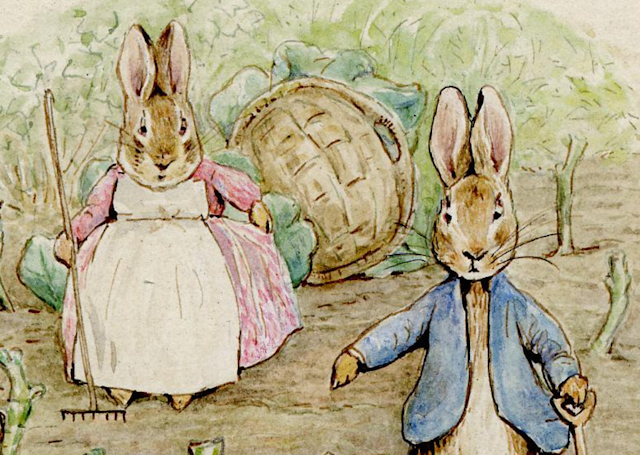Peter Rabbit, the cute and wily bunny who wears a bright blue jacket, is the best-selling creation of English author Beatrix Potter. Originally published in 1902, the Tale of Peter Rabbit – the first of 23 tales in the series – has since been translated into more than 45 languages and sold over 45 million copies.
Peter’s home is the Lake District in north-west England, among ancient stone walls and picturesque rolling hedgerows that crisscross emerald fields. Heralded as Britain’s best-loved children’s author, Potter received much praise for her originality as well as her artistic and literary skills during her lifetime, and these “thoroughly English” tales continue to captivate young readers all over the world. The author was a frontrunner to appear on the UK’s latest £20 note, but was beaten by the painter J.M.W. Turner.
It is popularly held that Potter conceived of her tales in 1893, while writing to the sickly son of her friend and former governess, Annie Moore. In these letters she wrote and illustrated stories featuring her pet rabbit, Peter Piper.
As a scholar of folktales and postcolonial literature, however, I spend a lot of time tracing the roots of stories and examining the impact of colonial legacies on them. While rereading another collection of children’s stories featuring the “trickster hero” Brer Rabbit – for my own book on how these folktales were introduced to North America by enslaved Africans – it became clear to me that the similarities between Beatrix Potter’s tales and the Brer Rabbit stories demand further consideration.

This article is part of Conversation Insights
The Insights team generates long-form journalism derived from interdisciplinary research. The team is working with academics from different backgrounds who have been engaged in projects aimed at tackling societal and scientific challenges.
The tales of Brer Rabbit can be traced back to pre-colonial Africa, from where they were transported to the plantations of America by enslaved people. The stories were first adapted for a white audience in the late 19th century by the American journalist and folklorist Joel Chandler Harris.
Harris created a fictional African American narrator for his stories, Uncle Remus, whose name became the popular title for his collections. Brer Rabbit is a cunning trickster who lives in a briar (bramble) patch and outwits larger animals using his brains rather than his brawn.
In her 2008 biography of Potter, A Life in Nature, Linda Lear notes that while the author’s “first audience was British”, her work was strongly influenced by Harris – “whose Brer Rabbit stories she had loved as a child”. Lear also writes that Potter’s tales “were favourably compared to Uncle Remus in early reviews of her work”.
And yet, I was amazed to realise how little comment there has been over the years about the many similarities between Potter’s tales and the Africa-originated Brer Rabbit folktales. Indeed, one of the most striking references, cited in Lear’s biography, is found in a letter that Potter herself wrote to her publisher, Harold Warne, on November 18 1911. The letter is about her new Peter Rabbit story The Tale of Mr Tod, and directly refers to her use of the Uncle Remus folktales in this work:
I think the story is amusing; its principal defect is its imitation of ‘Uncle Remus’. It is no drawback for children, because they cannot read the Negro vernacular. I hardly think the publishers could object to it? I wrote it some time ago. I have copied it out lately.
We don’t know how Warne responded to this letter. However, having analysed the plotting, language and characters in Potter’s tales, it’s clear that she was more than just inspired by these folktales. Her tales owe a debt to the Brer Rabbit stories told by enslaved Africans working on American plantations that needs to be fully acknowledged.
Early encounters with Brer Rabbit
Potter knew Harris’s Brer Rabbit folktales as a child, having first encountered them in her father Rupert Potter’s library in their grand London home. Copies of the collections Songs and Sayings and its sequel Night with Uncle Remus were found at her farmhouse home in Sawrey in the Lake District after she died in 1943. Each bore her father’s bookplate.
These stories had not been published in the UK when Beatrix Potter was a child. It is therefore likely that her early contact with the Brer Rabbit tales (in comparison with the rest of the British public) was a result of her family roots in the cotton industry.
Her grandfather, Edmund Potter (1802–1883), was a Manchester cotton mill owner and industrialist. He became wealthy in the calico printing business, a cotton cloth originating from India.
Under the British East India Company (1600-1874), the cotton industry was an exploitative one. Cotton was grown by “peasant cultivators” in India who were heavily taxed. At the same time, the growth of demand in Britain and the development of British weaving techniques destroyed the traditional Indian cotton manufacturing industry.
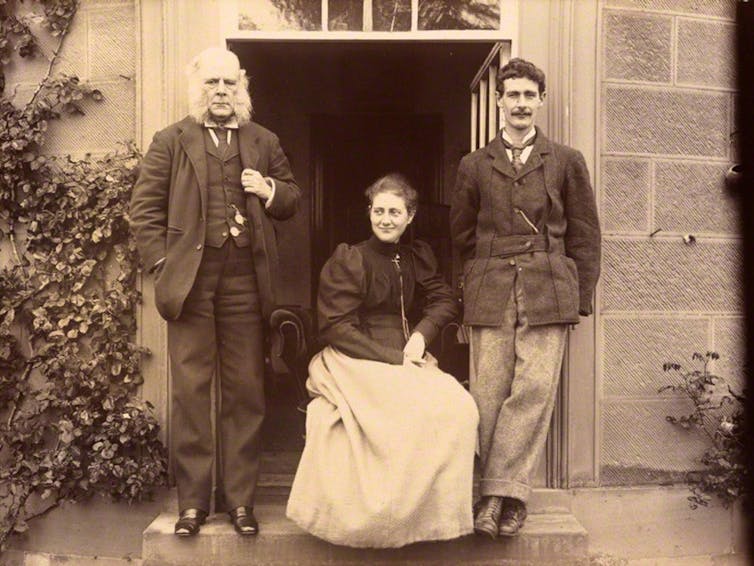
In Manchester, Edmund Potter introduced precision machinery to his calico printing process. By 1883, his mill employed 350 workers – many of them children, according to Lear’s biography – and was the world’s largest calico printing factory.
A great portion of Edmund Potter’s wealth was passed on to Beatrix’s father, Rupert, a lawyer and photographer. He married a wealthy heiress, Helen Leech, whose family had also made a fortune in Manchester’s cotton industry by owning several cotton-spinning mills. By the early 19th century, the raw cotton used in these mills was sourced from the Americas, including from the Sea Islands region and Charleston in South Carolina.
This was the time of Manchester’s emergence as the world’s “cotton capital”. The city’s economic success was deeply connected to the enslavement of African people. Its industry predominantly involved the production of cloth made from raw cotton that had been picked by enslaved people on plantations in the Caribbean and US.
Many of the dyes such as logwood used in the printing of cotton were also imported from places such as Belize (known then as British Honduras) in the British Caribbean, and would have been harvested by enslaved people.
So, was it the Potter family’s connections with the cotton industry, the US, and the slave trade that brought a plantation Brer Rabbit into the Potter household?
How Potter fell in love with the Uncle Remus stories
As noted in my book, American Trickster: Trauma, Tradition, and Brer Rabbit, there are only two detailed pieces of research connecting Potter’s tales with Harris’s earlier folktales.
The first is children’s author John Goldthwaite’s 1996 book, The Natural History of Make-Believe. This was used as a key source in the other important contribution, literary critic Peter Hollindale’s (unpublished) lecture Uncle Remus and Peter Rabbit, delivered in 2003 at the Beatrix Potter Society’s annual general meeting.
I found the title of Hollindale’s lecture on the society’s website and wrote to ask if he would share its contents. His wife typed up the lecture from his handwritten notes, and I am grateful for their assistance with my research.
From her earliest creative forays, the influence of Brer Rabbit on Potter was evident in her work. In 1893, when establishing herself as an illustrator for her writing, she did the first of eight Uncle Remus drawings – presumably having been inspired by A.B. Frost’s illustrations in Harris’s books. More followed in 1895 and 1896.
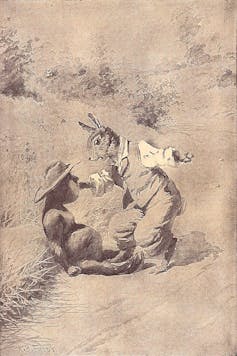
Potter illustrated Harris’s tales for fun, it seems, and to stretch her artistic talent. She was not commissioned to do so, and there’s no indication that Harris was aware of her drawings or ever saw them.
There are, however, clear resemblances between Potter’s Uncle Remus illustrations and those in her tales of Peter Rabbit. For example, her illustration of Brer pretending to be Mr Billy Malone in the Remus tale In Some Lady’s Garden is very similar to her drawing of Peter and Benjamin in The Tale of Peter Rabbit and Benjamin Bunny, with both rabbits wearing fitted jackets and hats in an English country garden.
There are also similarities in her illustration of the Remus tale Brother Rescues Brother Terrapin with those she did of the fox character, Mr Tod, and the interior of his home for The Tale of Mr Tod.
Potter never publicly admitted the source of any inspiration for her drawings, plotlines or protagonists. But in his lecture, Hollindale argued that she “misunderstood her own talent and, to the end of her life, was afraid of being caught out as a cheat”.
Indeed, in a diary entry in 1883, Potter wrote as if plagiarism were a viral illness
It’s a risky thing to copy. Shall I catch it?
The African roots of the Peter Rabbit tales
The Brer Rabbit folklore character originated from the hare trickster figure of the Bantu-speaking peoples of south, central and east Africa. We know the origins of the tales through careful comparisons of plot, structure, language and characters in the stories. Brer was brought to the Americas by enslaved people and became a well-known folk figure across the French-speaking Caribbean and US.
In the Francophone Caribbean and American states, in particular Louisiana, the African hare was called Compère Lapin (Brother Rabbit), while in the English-speaking US he was known as Brer Rabbit.
This cunning trickster was known for outwitting his often more powerful animal adversaries using brains rather than brawn. The tales came to embody the tactics of resistance that enslaved people implemented to survive the brutality of plantation life. Harris adapted them while living on the Turnwold cotton plantation in the southern US state of Georgia in the late 19th century. He would spend his evenings in the quarters of the enslaved workers, listening to them share these stories.
Harris’s fictional narrator, Uncle Remus, was a formerly enslaved old man who was content with plantation life and for whom everything was “satisfactory”. Remus was based on, and propagated, a racist, minstrel-style stereotype that was deeply embedded into white American culture and consciousness.
Harris’s versions of the Brer Rabbit tales were sanitised to entertain white readers. The violence and injustice at the heart of both plantation life and the traditional folktales were tempered. Instead, Harris’s stories offered a more benign view of slavery.
Following on from the US’s emancipation proclamation of 1863, Harris’s portrayal of Uncle Remus, the “happy slave”, fed a white American nostalgia for its plantation past as a time when everybody knew their place. In this fantasy, unruly or child-like enslaved people were guided and cared for by benevolent white masters.
In an angry 1981 essay, Uncle Remus, No Friend of Mine, the African American author Alice Walker accused Harris of stealing part of her heritage and making her “feel ashamed of it”. Walker described feeling “separated from [her] own culture by an invention”, adding:
Even our folklore has been ridiculed and tampered with. And this is very serious, because folklore is at the heart of self-expression, and therefore at the heart of self-acceptance.
Poaching plantation stories
One of the key elements that Harris preserved in his retellings of the oral plantation folktales was the African American vernacular. And some of these turns of phrases and ways of speaking found their way directly into Potter’s stories.
Terms like “rabbit tobacco”, “puddle-duck”, “lickety-split” and “cottontail” are not English at all, but have been lifted from the African American vernacular she learned and enjoyed in the Remus tales.
And when writing about the success) of her tales, Potter referenced a “mischievous” enslaved character, Topsy, from Harriet Beecher Stowe’s plantation novel, Uncle Tom’s Cabin:
I have never quite understood the secret of Peter’s perennial charm. Perhaps it is because he and his friends keep on their way, busily absorbed with their own doings. They were always independent. Like Topsy, they just “grow’d”.
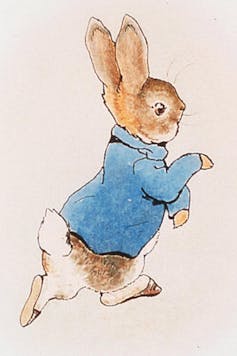
There are also numerous similarities in the plots of Harris’s and Potter’s tales. In Some Lady’s Garden (1883), for example, Brer Rabbit tricks Miss Janey into letting him into her father’s vegetable garden to steal English peas, sparrow grass (asparagus) and goobers’(peanuts) by pretending to be a friend of her father, Mr Man, from the big white (master’s) house.
This plot is the main storyline in most of Potter’s tales and is directly linked to the need for enslaved people to steal food from their masters to survive. In the most famous of Potter’s tales, Peter Rabbit repeatedly tries to steal vegetables from Mr McGregor’s garden.
But her Tale of Mr Tod is the one most clearly based on Harris’s narratives. Its plot centres on overcoming neighbourhood bullies, the badger Tommy Brock and the fox Mr Tod. In her biography of Potter, Lear explains that she copied the tale out from Uncle Remus, then changed the setting to the Lake District’s Sawrey countryside.
In his book, Goldthwaite traces the close connections between this tale and Harris’s Brother Rabbit Rescues Brother Terrapin (1883), which features a kidnapping, rescue and fight. Mr Tod follows a very similar narrative arc and, in some sections, exactly the same action plays out – for instance, a fight in the kitchen featuring crashing furniture.
For the average British reader, the vernacular in Harris’s tales would have been challenging to understand, and perhaps Potter’s knack for translation helped her cover her tracks. Take that kitchen fight. Harris’s story reads:
Dey year de cheers a-fallin’, en de table turnin’ over, en de crock’ry breakin’, en den de do’ flew’d open, en out come Brer Fox, a-squallin’ lak de Ole Boy wuz atter ‘im.
[They hear the chairs falling, and the tables turning over, and the crockery breaking, and then the door flew open, and out comes Brer Fox, squalling like the Old Boy was after him.]
Compare this with Potter’s tale:
There was a terrific battle all over the kitchen […] Everything was upset except the kitchen table. […] The crockery was smashed to atoms. […] The chairs were broken. […]
The environment Potter creates in her tales shares similarities to that of a plantation – a dangerous world where the fight for food and survival is paramount. Despite the backdrop of gentle Lake District landscapes and an English cottage garden, her tales are set in a context of merciless repercussions for those who don’t have the wits to avoid capture – including Peter Rabbit’s father, who we discover has been baked in a pie.
In a 2006 article entitled The Ugly Truth of Peter Rabbit, journalist Stuart Jeffries asked: “Should we be celebrating this creator of a dark, sadistic, bloodthirsty world?” He argued that Potter’s stories are a bad influence on children, but did not mention that the stories are drawn straight out of an American slave plantation environment.
‘Pretence of absolute originality’
Potter’s use of the Brer Rabbit stories as the basis of her tales is not the main issue here. This is the traditional way that folktales travel across cultures and geographies. As Goldthwaite puts it, Harris’s series was the “base camp” from which Potter could work.
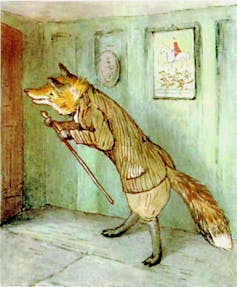
However, the steps Potter took to steer readers away from her sources are problematic. She appears to have been keen to claim the stories as her own, while ensuring that readers didn’t make the connection between Peter Rabbit and the stories narrated by Uncle Remus. Potter used the introductions to some of her tales to emphasise her authorship, using phrases such as “I remember” and “I can tell you” as if taking the place of Harris’s fictional narrator.
In the introduction to The Tale of Mr Tod, the darker sequel to The Tale of Peter Rabbit, Potter writes:
I have made many books about well-behaved people. Now, for a change, I’m going to make a story about two disagreeable people, called Tommy Brock and Mr Tod.
In his book, Goldthwaite writes of Potter’s “deception”, suggesting that those of Potter’s tales that were the most heavily indebted to Harris’s stories open with “pretence of absolute originality”:
Once satisfied that her translation from Uncle Remus has “grow’d” sufficiently, Potter stamps it officially as hers in the first person singular … What these introductions imply is that fresh work is being undertaken here, and that is the deception.
Goldthwaite adds that Potter’s “fear of being exposed as copyist would lead to a lifelong silence about Uncle Remus”.
It seems that the only references Potter herself made to her stories being drawn from Harris’s Brer Rabbit tales were in that single journal entry and letter. In his lecture to the Beatrix Potter Society, Hollindale commented on the oddity of this omission:
Strange, isn’t it, when you think that Black Rabbit, as in Mr Tod, is a glance at Brer Rabbit, and Cottontail is an Uncle Remus name, and an animal running “lippity lippity” first does so in Uncle Remus, and rabbit tobacco […] comes from there, not to mention some important elements of plotting? But [Potter] didn’t say much [about this].
At the same time, however, she did embed little clues regarding her Uncle Remus sources, making reference to “a fox coming up the plantation” in The Tale of Mr Tod, for example. In Goldthwaite’s view, these hints could be interpreted as a “careless shoplifter who secretly wants to get caught”.
I suspect Potter struggled to steer her work away from Harris’s tales. They absorbed her, they were central to her work in every way, and she enjoyed them. Rather than “clues”, these may be slippages – moments when Potter forgot to recast the story in her Lake District setting and slipped back into the world of Brer Rabbit.
At the same time, Potter expressed some strong ideas about other copycats – once accusing the children’s writer and illustrator Ernest Aris of plagiarism . At first she was, according to Lear’s biography, “strangely” defensive of Aris and his portrayal of a rabbit who happened to be named Peter. But later, Potter had a change of heart and wrote to him claiming his work had “no originality” and that “coincidence has a long arm, but there are limits to coincidences”.
This seems an ironic statement in light of Potter’s own silence around Brer Rabbit and the Uncle Remus tales.
Another famous Brer Rabbit fan
By their nature, stories constantly change to suit the needs of their audiences, and this is particularly the case with oral storytelling. Prior to Harris’s adaptations, the Brer Rabbit tales had already been remoulded to an American plantation environment by enslaved people from Africa. As such, there are no “authentic” versions of these folktales, which will continue to be told and adapted to new environments, moulded by the needs of the people that tell the tales.
Another British children’s author, Enid Blyton, also wrote versions of the Brer Rabbit stories, many of which were first published in magazines from the late 1930s onwards. Like Potter, Blyton understood the attractiveness of these folklore-based tales to British children – their delight in scams and tricking grown ups. However, Blyton acknowledged her sources.
Blyton began creating her Brer Rabbit stories in 1934 when she lived in Buckinghamshire. A big fan of Harris’s versions, she adapted them to a middle-class English country setting, further tempering the violence and adding some new characters, including her own beloved dogs and even unicorns. In all, Blyton wrote 338 Brer Rabbit tales as well as a play in 1939 and a cartoon strip.
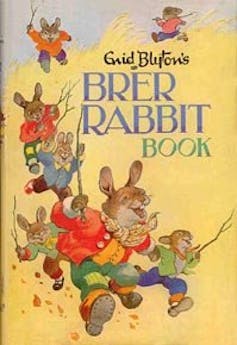
In the introduction to her collection Heyo, Brer Rabbit: Tales of Brer Rabbit and His Friends Retold From the Original (1938), Blyton describes the spread of the trickster rabbit figure around the world under different names, but insists the most delightful is his incarnation as Brer Rabbit – folktales she attributes to “the American Negro’s Friend and Brother Creature”.
Blyton explains that Harris’s stories were told in “difficult negro vernacular”, so she set about the “delightful” task of retelling the stories in her own way while retaining the “raciness” of the original stories, claiming that “Brer Rabbit has always been my favourite character”.
Like Potter, Blyton includes many phrases from Harris’s African American vernacular in her stories, such as “bless gracious”, “lay low”, “lippity, clippity” and “a-going”. Blyton’s collection The Wonder Book for Children (1948) includes three stories entitled Brer Rabbit Tales by Enid Blyton After J.C. Harris. They are illustrated by the artist behind Harris’s later editions, Harry Rountree, with Brer Rabbit smoking a pipe or cigar.
Ending the silence and changing the narrative
Both Potter and Blyton, constrained by patriarchal power and middle-class social etiquette, may have revelled in fantasies of breaking through the social boundaries and rules that constrained most women to roles as wives and mothers during their lifetimes. Perhaps they found a sense of freedom in the Brer Rabbit stories and the trickster’s anarchic antics.
Goldthwaite argues that Potter was drawn to these folktales as they enabled her to resist and subvert her “domestic plight” as a young woman living with her father and having to adhere to strict Victorian patriarchal codes of conduct. In Brer Rabbit, he suggests that Potter found what she loved:
The sheer joy of wiliness, the world of the trickster and subversive mischief-maker.
Literary critics have argued that Potter’s tales are anti-imperialist or anti-capitalist, highlighting the problems of private property and the struggles of the dispossessed. It has also been said that Potter created a sexist world in which only men have adventures and can misbehave.
But above all, Peter Rabbit and the rest of Potter’s tales are viewed as quintessentially English stories about characters conjured from Potter’s brilliant mind and inspired by her life in rural England. Yet her tales are, at heart, folktales that originated in Africa before being adapted to expose and reflect the violence, resistance and survival tactics of the plantation life of enslaved people in the Americas.
While Potter, according to the letter and diary entry mentioned earlier, was, at least initially, anxious about imitating Harris, both Hollindale and Goldthwaite ultimately concluded that she felt needlessly guilty about her “borrowing” and “deception” tactics, obvious as they felt these were.
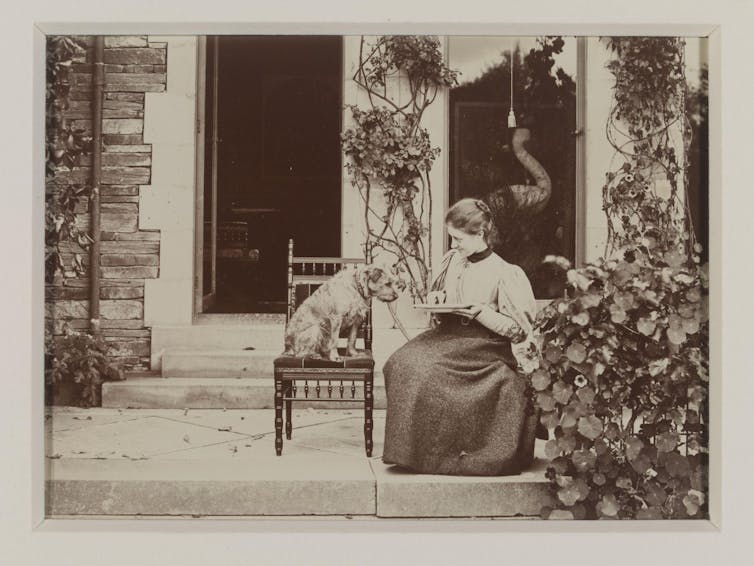
Both academics are clearly great admirers of Potter, who is considered a national treasure – not only for her tales but for her conservation work and the bequeathing of her extensive land and property to the National Trust. She has very few critics.
However, in my view, Hollindale and Goldthwaite miss the point in their conclusions. Potter’s actions in shielding the reading public from her sources have fed into a damaging and reoccurring appropriation of black cultural forms that continues today.
The Beatrix Potter and Peter Rabbit brands are highly lucrative. Yet I have found no references to the black American sources of these tales in any of the Beatrix Potter museums and experiences in the UK and US, which attract hundreds of thousands of visitors yearly. There is similarly no mention of these sources in any of the films of her tales, nor in the 2006 Hollywood biopic Miss Potter.
While Harris moved the stories out of the reach of many African Americans and created a damaging minstrel stereotype in Uncle Remus, he did at least credit enslaved black Americans as the storytellers – while describing himself as a “humble compiler and transcriber”).
In contrast, through Potter’s silence concerning her sources, the African American tales that helped create her stories are passed over without acknowledgement or celebration. Brer Rabbit must be firmly reasserted into our understanding and appreciation of Beatrix Potter’s tales. For far too long, they have been stealing from his briar patch.

For you: more from our Insights series:
To hear about new Insights articles, join the hundreds of thousands of people who value The Conversation’s evidence-based news. Subscribe to our newsletter.

